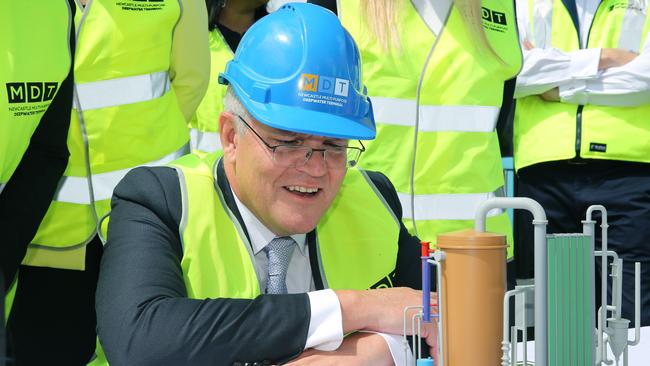Scott Morrison’s plan to tackle transport emissions revealed
Scott Morrison has promised that the nation’s plan to tackle transport emissions won’t “force Australians out of the car”.
Victoria
Don't miss out on the headlines from Victoria. Followed categories will be added to My News.
THE transition to electric vehicles will be accelerated by a $250m federal government fund to rollout out charging infrastructure and drive down costs in a bid to get 1.7 million clean cars on the road come 2030.
Scott Morrison says the nation’s take-up of low and zero emission vehicles can rival our world-leading approach to rooftop solar with investment in new technologies.
The Prime Minister and Energy Minister Angus Taylor will on Tuesday unveil the government’s new Future Fuels and Vehicles strategy to help Australia slash transport emissions and reach net zero emissions by 2050.
“We will not be forcing Australians out of the car they want to drive or penalising those who can least afford it through bans or taxes,” Mr Morrison said.
“Just as Australians have taken their own decision to embrace rooftop solar at the highest rate in the world, when new vehicle technologies are cost competitive, Australians will embrace them too.”
Mr Morrison was on Monday in Newcastle where he announced a new hydrogen hub partnership before heading to Victoria, where he will spend this week.

The federal government will funnel $178m into the expanded fund, which aims to spur co-investment from industry for the development of new technologies to reduce the cost of low and zero emission vehicles.
One priority area is the cost of batteries, which are the main contributor to electric battery vehicles being expensive.
“Integral to electric vehicles reaching price parity with conventional vehicles is a reduction in the cost of manufacturing lithium-ion batteries, as a result of industry innovation,” the report states.
By 2030, battery electric and plug-in hybrid electric vehicles are projected to make up 30 per cent of new passenger and light commercial vehicle sales.
This translates to over 1.7 million battery electric and plug-in hybrid vehicles on Australian roads by the end of the decade, according to the report.
“By enabling this increased uptake, the expanded Future Fuels Fund is expected to reduce emissions by 8 Mt of CO2 equivalent by 2035.”
The fund is expected to result in 2600 new jobs and more than $500m of combined private and public co-investment.
This investment is expected to deploy charging infrastructure in over 400 businesses, 50,000 households and 1000 public charging stations.

At least four in five Aussies will have access to public fast charging, which the government hopes will give drivers and businesses the confidence to purchase low emission vehicles.
Hydrogen refuelling infrastructure for road transport, and the manufacturing of battery and hydrogen trucks and buses is also in the plan.
The fund will also include more support for business fleets, and provide co-investment to households for “smart chargers” that will boost the reliability of local power networks.
Taking “early action” to manage the stress EVs could put on the grid is estimated to avoid around $224m in electricity network upgrades being passed on to households.
Mr Morrison in August declared his claim that Labor’s electric vehicle policy at the last election would “end the weekend” did not mean he was opposed to EVs.





